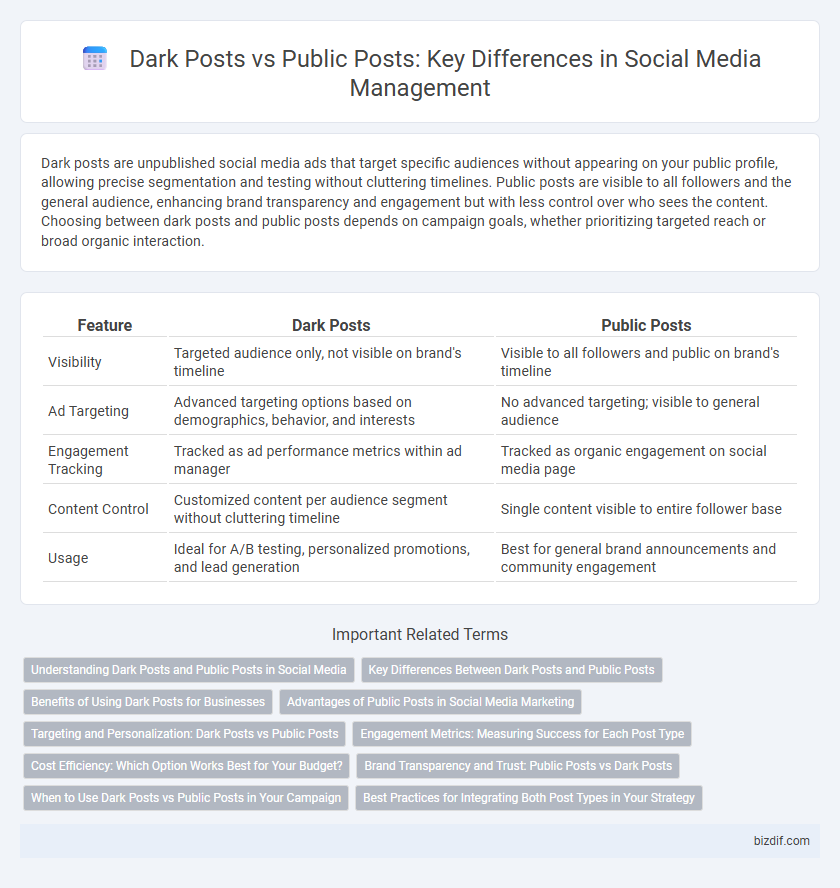Dark posts are unpublished social media ads that target specific audiences without appearing on your public profile, allowing precise segmentation and testing without cluttering timelines. Public posts are visible to all followers and the general audience, enhancing brand transparency and engagement but with less control over who sees the content. Choosing between dark posts and public posts depends on campaign goals, whether prioritizing targeted reach or broad organic interaction.
Table of Comparison
| Feature | Dark Posts | Public Posts |
|---|---|---|
| Visibility | Targeted audience only, not visible on brand's timeline | Visible to all followers and public on brand's timeline |
| Ad Targeting | Advanced targeting options based on demographics, behavior, and interests | No advanced targeting; visible to general audience |
| Engagement Tracking | Tracked as ad performance metrics within ad manager | Tracked as organic engagement on social media page |
| Content Control | Customized content per audience segment without cluttering timeline | Single content visible to entire follower base |
| Usage | Ideal for A/B testing, personalized promotions, and lead generation | Best for general brand announcements and community engagement |
Understanding Dark Posts and Public Posts in Social Media
Dark posts are unpublished social media ads that appear only to targeted audiences without showing on the brand's public timeline, allowing precise ad targeting and testing without cluttering the main feed. Public posts are visible to all users on a brand's social media profile, promoting transparency and broad engagement but lacking the targeted precision of dark posts. Understanding the strategic use of dark posts versus public posts enables marketers to optimize reach, engagement, and conversion based on campaign goals and audience segmentation.
Key Differences Between Dark Posts and Public Posts
Dark posts on social media are unpublished ads that target specific audiences without appearing on a brand's public timeline, optimizing segmentation and tailored messaging. Public posts are visible to all followers and can boost organic engagement but lack precise audience targeting and measurement capabilities. Choosing between dark posts and public posts depends on campaign goals, such as testing content effectiveness or maximizing brand reach.
Benefits of Using Dark Posts for Businesses
Dark posts allow businesses to target specific audience segments without cluttering their public feed, enabling precise message customization and improved ad relevance. These unpublished posts provide valuable opportunities for A/B testing, enhancing campaign performance based on real-time insights. Utilizing dark posts helps optimize budget allocation by focusing spend on high-converting demographics and minimizing ad fatigue among a broad audience.
Advantages of Public Posts in Social Media Marketing
Public posts on social media enhance brand transparency and trust by allowing followers to engage openly, increasing organic reach and community interaction. These posts contribute to better SEO performance as search engines index public content, driving more traffic to brand profiles and websites. Consistent public posting cultivates brand awareness and credibility, encouraging potential customers to share content and amplify marketing efforts.
Targeting and Personalization: Dark Posts vs Public Posts
Dark posts enable precise targeting and personalized content delivery to specific audience segments without cluttering the brand's public timeline, optimizing ad spend and engagement rates. Public posts, while visible to all followers and potential organic reach, lack the ability to customize messaging for distinct demographics, limiting personalization effectiveness. Leveraging dark posts in social media management allows brands to tailor content based on user behavior, interests, and demographics, enhancing campaign relevance and conversion potential.
Engagement Metrics: Measuring Success for Each Post Type
Dark posts on social media enable precise targeting and often yield higher engagement metrics such as click-through rates and conversions due to their tailored audience focus. Public posts generate broader organic reach and interactions like comments and shares, contributing to overall brand visibility. Measuring success requires analyzing engagement metrics including reach, impressions, clicks, and conversion rates specific to each post type to optimize social media strategy effectively.
Cost Efficiency: Which Option Works Best for Your Budget?
Dark posts enable precise targeting without cluttering your public feed, often resulting in higher engagement rates and lower cost-per-click compared to public posts. Public posts build brand trust through visible interaction but may require a larger budget to achieve the same level of audience reach. For businesses with tight budgets, dark posts offer superior cost efficiency by delivering tailored ads to specific user segments, maximizing ROI on social media campaigns.
Brand Transparency and Trust: Public Posts vs Dark Posts
Public posts foster brand transparency by being visible to all users, which builds trust through open communication and accountability. Dark posts, or unpublished ads, target specific audiences without public visibility, potentially reducing perceived transparency and limiting opportunities for organic engagement. Brands prioritizing trust typically favor public posts to demonstrate openness, while dark posts are often used strategically for tailored messaging without broad scrutiny.
When to Use Dark Posts vs Public Posts in Your Campaign
Dark posts enable precise targeting by appearing only in selected users' feeds, ideal for testing different ad creatives or messages without cluttering your public timeline. Public posts maximize organic reach and brand visibility, making them suitable for broad awareness campaigns and engaging a wider audience. Choose dark posts for segmented audience engagement and public posts to boost overall brand presence and community interaction.
Best Practices for Integrating Both Post Types in Your Strategy
Integrate dark posts and public posts by leveraging dark posts for targeted audience testing and personalized messaging, while utilizing public posts to build brand awareness and engage a broader community. Utilize audience insights gathered from dark post performance to refine public content that resonates and drives organic interaction. Maintain consistent branding and messaging across both post types to reinforce brand identity and optimize overall social media ROI.
Dark posts vs Public posts Infographic

 bizdif.com
bizdif.com